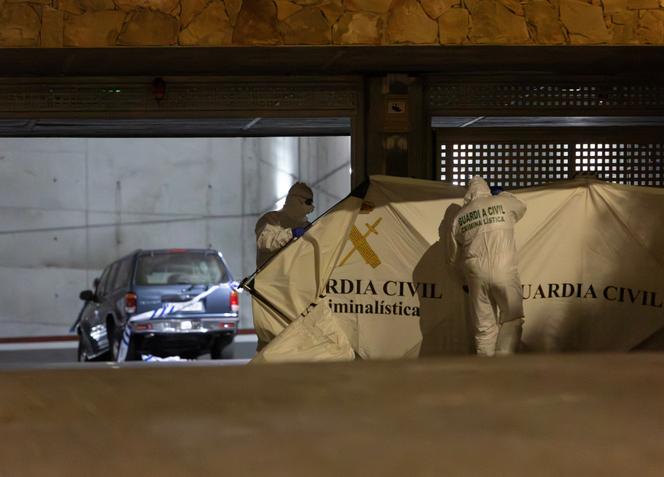


Just four days after the death in prison of Russian opposition figure Alexei Navalny, the Kremlin's shadow once again looms over the death of a Russian army defector. Maxim Kuzminov crossed over to the Ukrainian side this summer at the end of an operation that made the Ukrainian special forces proud, and whose improbable itinerary ended in Spain.
According to sources close to the Guardia Civil, quoted on Tuesday by El Pais, the body found riddled with bullets last week near Alicante is indeed that of Kuzminov, a Russian helicopter pilot who had defected six months earlier. The 28-year-old was identified by fingerprints, the daily paper reported. However, a Guardia Civil spokesperson contacted by Le Monde said that she has not yet received the result of the fingerprint identification transmitted to Interpol.
Six days earlier, regional daily newspaper Informacion, citing the Guardia Civil, announced that a man had been shot half a dozen times in the chest in Villajoyosa, a fishing village on the Costa Blanca, suggesting the possibility of a settling of scores. The papers found on his body identified him as a 33-year-old "Ukrainian citizen." During the investigation, it became clear that the identity used by this person could be false, a spokeswoman for the Spanish Interior Ministry told Le Monde on Monday.
His body was discovered in the underground parking lot of the residential complex where he lived along with many other expatriates, including Ukrainians, Russians and Bulgarians. According to Informacion, his two killers fled in a car that was found burnt out some 20 kilometers away.
Andriy Yusov, spokesperson for Ukraine's Main Directorate of Intelligence (GUR), had already confirmed the pilot's death to Kyiv Post on Monday and on public television, without specifying either the location or the circumstances. An anonymous member of Ukraine's intelligence services later told Ukrainska Pravda that Kuzminov had decided to move to Spain. "From what we know: He invited his ex to his place and was found shot dead," he added.
"This traitor and criminal became a moral corpse at the very moment when he planned his dirty and terrible crime," said Sergey Naryshkin, head of Russia's foreign intelligence service (SVR), on Tuesday, without mentioning any responsibility on Moscow's part. To further thicken the mystery, others, again on the Russian side, suggest that the pilot is very much alive and that his death was staged to guarantee his safety.
"Don't get too excited. The GUR is just strengthening the disinformation of Tsipso [Ukraine's Center for Information and Psychological Operations]," wrote Vladimir Rogov, a member of the administration of the Russian-occupied part of the Zaporizhzhia oblast, on Telegram on Monday. "They want to create a new biography with a clean slate and a new name for the traitor."
According to his own account, delivered in front of TV cameras a few weeks after his defection, Kuzminov, a member of the 319th Russian air force helicopter regiment, took advantage of an August 9 transport mission. From the Kursk air base, he fled at the controls of his MI-8 helicopter to the Kharkiv oblast, where members of the GUR were waiting for him.
"The truth is there are no fascists or Nazis here. It’s a real disgrace what is happening here. Murder, tears, blood (...) I don’t want to be a part of it," he explained to the Ukrainian press on September 5, in the presence of General Kyrylo Budanov, head of the GUR. Six months earlier, he added, he had contacted members of the Ukrainian intelligence services to explain his intentions. "Come on, we guarantee your safety, guarantee new documents, guarantee monetary compensation [of half a million dollars (€462,000)]," said the pilot, assuring that money was not the reason for his defection.
In a high-profile documentary broadcast at the same time, the Ukrainian special services said they had spent months preparing the operation, dubbed Chickadee, including getting his relatives out of Russia and securing the route, which didn't prevent the shots from being fired. "I can't say for sure who started it, but I assume it was the Russian side," said the pilot. "I realized that I was near the border. I relayed my location [to the Ukrainian special services]. I said, 'Let's give it a try, I'm not far away.' And, having made a final decision, I flew at an extremely low altitude in radio silence mode (...) and landed."
At his side were two other crew members whom he said he tried in vain to convince to follow him as he fled. "They got afraid, began behaving aggressively and eventually rushed out of the helicopter, heading for the border," he continued. According to Ukrainian intelligence, they chose "not to surrender and lost their lives upon landing."
The incident also caused a stir in Russia. In a program broadcast at the beginning of October on the Rossiya 1 channel, journalist Sergei Zenin claimed that the GRU had been ordered to eliminate Kuzminov, and also accused him of having executed the other two crew members himself.
In addition to the pilot's defection and the seizure of his helicopter and the Sukhoi Su-27 and Su-30 SM fighter parts it was carrying, the GUR claimed to have acquired valuable intelligence. It even compared this operation to the one that enabled Mossad to seize a MiG-21, the flagship of the Soviet air force at the time, in 1966.
Translation of an original article published in French on lemonde.fr; the publisher may only be liable for the French version.
